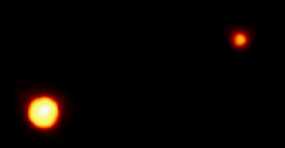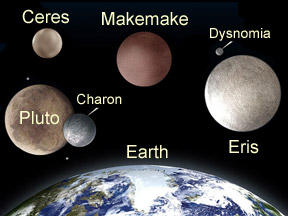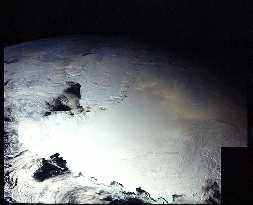Click on image for full size
Image courtesy Dr. R. Albrecht (ESA/ESO Space Telescope European Coordinating Facility) and NASA.
The Moons of Pluto
Pluto has known moons. Charon, the largest by far, was discovered in 1978 by the American astronomer James Christy. The other two moons, which are much smaller, were spotted in 2005 by a team led by Alan Stern and Harold Weaver.
Charon is so large compared to Pluto, and orbits so close to the planet, that many astronomers call the pair a "binary planet" (double planet). Like Earth's moon, Charon always keeps one face towards Pluto, for the moon's orbital period and rotational period (the length of its day) are identical.
The smaller moons bear the temporary names S/2005 P1 and S/2005 P2 until their discoveries can be confirmed. S/2005 P1 is about 150 km (93 miles) across, and orbits Pluto once every 38 days at a distance of 64,500 km (40,100 miles). S/2005 P2 is about 100 km (62 miles) across, and orbits the planet every 25.5 days at a distance of 49,500 km (30,800 miles). Stern, Weaver, and their colleagues found the moons in May 2005 using the Hubble Space Telescope. They were intentionally searching for new moons of the distant planet in preparation for the New Horizons space mission to Pluto. Their survey led them to believe that if Pluto has any more moons, they must be very small; less than about 16 km (10 miles) in diameter.
S/2005 P1 and S/2005 P2 will be given permanent names after their discoveries have been confirmed by further observations. Confirmation seems almost certain, since other astronomers have already identified the moons in older Hubble photos from June 2002 that they took a second look at after hearing of the discoveries.
If Pluto has any rings, we haven't yet been able to see them.












